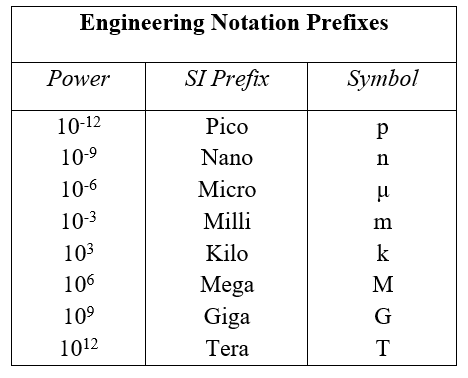Unit 1.3: Scientific and Engineering Notation
Scientific and Engineering Notation is a way to express really large numbers or really small numbers without needing to write zeros.
For example, the Earth weighs 13,170,000,000,000,000,000,000,000 lbs. It would be difficult to write that many zeros out every single time so we can use Scientific Notation
Scientific Notation
Scientific Notation takes this format:
A.AA x 10B
A can be any integer and B can be any integer (both positive, negative or zero). B will be determined by the number of zeros that the number has when in Standard Notation.
Standard notation, or General Notation is the form a number takes when not in Engineering or Scientific Notation.
It is important to note that when using Scientific notation, there can only be one number in front of the decimal. We must have an exponent (B) that changes accordingly.
For numbers that were originally greater than 1, the exponent (B) will be positive. For numbers that were originally less than 1, the exponent (B) will be negative.
Example: Weight of the Earth
The Earth weighs 13,170,000,000,000,000,000,000,000.00 lbs
Since 13,170,000,000,000,000,000,000,000.00 > 1, the exponent we use will be positive (B)
We count how many times we move the decimal place to find B

Counting the loops, we see that we would have to move the decimal 25 times so that there is only 1 number in front of the decimal. Therefore, the exponent value is 1025
The weight of the Earth in scientific notation is
1.317 x 1025 lbs.
Example: Mass of a red blood cell
A red blood cell weighs 0.00000000000027 grams
Since 0.00000000000027 < 1, the exponent will be negative (-B)
We count how many times we move the decimal to find B

Counting the loops, we see that we would have to move the decimal 13 times so that there is only 1 number in front of the decimal. Because the original number was less than one, the exponent will be negative. Therefore, the exponent value is 10-13
The mass of a red blood cell in scientific notation is
2.7 x 10-13 grams
Engineering Notation
Engineering notation is similar to Scientific Notation, except that the exponent (B) will always be a factor of 3 (for example, 3, 6, 9, -9,-12), and we adjust the values of A accordingly
Engineering Notation can take this format
AAA.AA x 10B or AA.AA x 10B or A.AA x 10B
Where you can have 1, 2 or 3 numbers in front of the decimal, instead of just 1 (like Scientific Notation). B will be positive or negative depending on if the original number was greater than 1. The important thing to remember is B has to be a factor of 3.
We use special prefixes (SI, Engineering or Metric) to show the value of the exponent or B.

When converting a number with units, you will always keep the units, just add or subtract a prefix
Example: Converting Voltage (V)
If you have 50,000,000 V in a system, what would that be in Engineering notation?
Since 50,000,000.00 > 1, we know that we need to use a positive exponent (kilo, mega, giga or tera)

We can move the decimal 3 places (engineering notation comes in 3s!) but it would still be a large number. We move it 3 more places which would give us AA.AA x 10B
So we can write it as
50.00 x 106 Volts or
50 Mega Volts or
50 MV
Example: Converting Amperage (A)
If you had 0.0023 A in a system, what would that be in Engineering Notation?
Since 0.0023 < 1, we need to use a negative exponent (milli, micro, nano or pico)

We can move the decimal 3 places (engineering notation comes in 3s!) and get A.AA x 10B
So we can write it as
2.3 x 10-3 Amps or
2.3 milli Amps or
2.3 mA
Example: Converting from Engineering to Standard Notation
If you have 80 kV in a system and want to convert back to general notation
80 kV = 80 x 103
since k is kilo or 103
We move the decimal over 3 spaces

So 80 kV in general notation is 80,000.00 V
Remember: the units will ALWAYS stay the same, just the prefixes drop or add